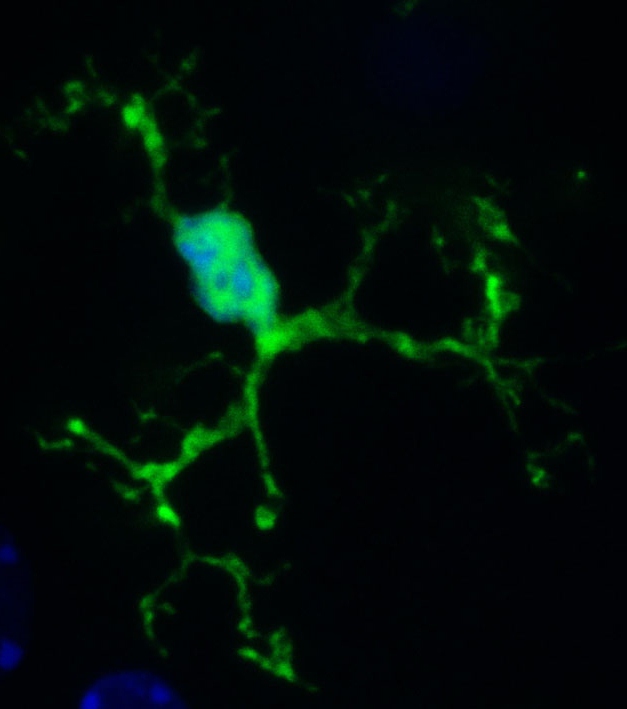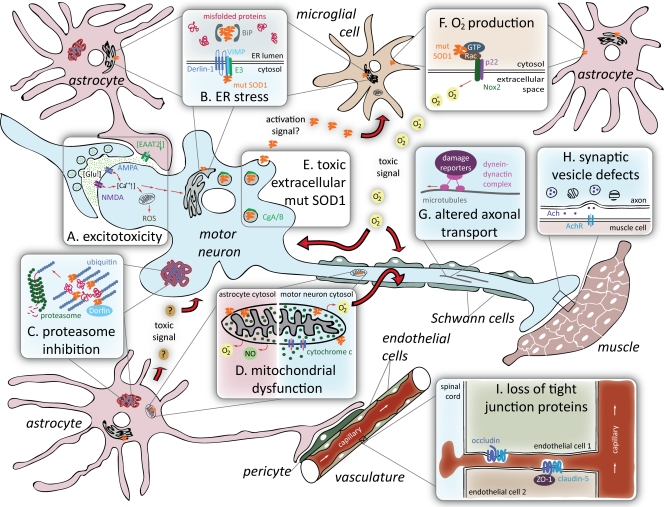
Stakeout. A microglial cell looks out for pathogenic intruders in the mouse brain. Image: Rosa Paolicelli, EMBL Monterotondo.
Since Jean-Martin Charcot MD described ALS during one of his Tuesday lectures at Paris' Salpêtrière Hospital in 1874, researchers around the world have looked hard at disease-ravaged motor neurons to try and figure out why these neurons fail in people with ALS. But in the 1980s, neurologist Stanley Appel MD, now at Methodist Neurological Institute in Houston, proposed that ALS was much more than a motor neuron disease. He suggested based on taking a look at spinal cord tissue from patients that the inappropriate activation of microglia and astrocytes – the primary immune cells of the central nervous system (CNS) – lead to a storm of cytotoxic substances that ultimately destroys the motor nerves. Research studies since then suggest that at least in mice, an orchestrated dialogue between microglia and motor neurons drives the progression of the disease.
ALS Today’s Michelle Pflumm PhD talked to Stanley Appel MD about the emerging role of cytotoxic microglia in ALS and potential treatment strategies to combat them looking forward.

The many insults to motor neuron injury. Misfolded proteins such as mutant superoxide dismutase 1 (SOD1) in people with ALS may lead to the deterioration of the motor nerves in part by triggering inflammation. Instigated in part by microglia that are activated either by misfolded proteins directly (E) or indirectly through distress signals (B), microglia produce toxic substances (F) that injure and ultimately destroy the motor nerves. Adapted from Ilieva, H. et al. (2009) Journal of Cell Biology.
References
Appel, S.H., Stockton-Appel, V., Stewart, S.S., and Kerman R.H. (1986) Amyotrophic lateral sclerosis. Associated clinical disorders and immunological evaluations. Archives of Neurology, 43(3), 234-238. Abstract | Full Text (Subscription Required)
Engelhardt, J.I., and Appel, S.H. (1990) IgG Reactivity in the Spinal Cord and Motor Cortex in Amyotrophic Lateral Sclerosis. Archives of Neurology, 47(11), 1210-1216. Abstract | Full Text (Subscription Required)
Boillée, S., Yamanaka, K., Lobsiger, C.S., Copeland, N.G., Jenkins, N.A., Kassiotis, G., Kollias, G., and Cleveland, D.W. (2011) Onset and progression in inherited ALS determined by motor neurons and microglia. Science, 312(5778), 1389-1392. Abstract | Full Text (Subscription Required)
Beers, D.R., Henkel, J.S., Xiao, Q., Zhao, W., Wang, J., Yen, A.A., Siklos, L., McKercher, S.R., and Appel, S.H. (2006) Wild-type microglia extend survival in PU.1 knockout mice with familial amyotrophic lateral sclerosis. Proceedings of the National Academy of Sciences, 103(43), 1621-1626. Abstract | Full Text
Further Reading
Appel, S.H., Beers, D.R, and Henkel, J.S. (2008). T cell-microglial dialogue in Parkinson's disease and amyotrophic lateral sclerosis: are we listening? Trends In Immunology, 31(1), 7-17. Abstract | Full Text (Subscription Required)